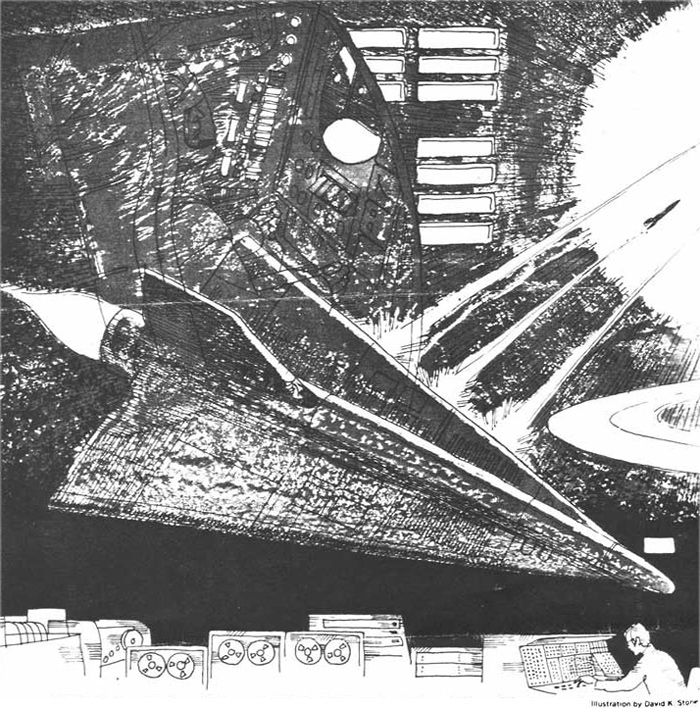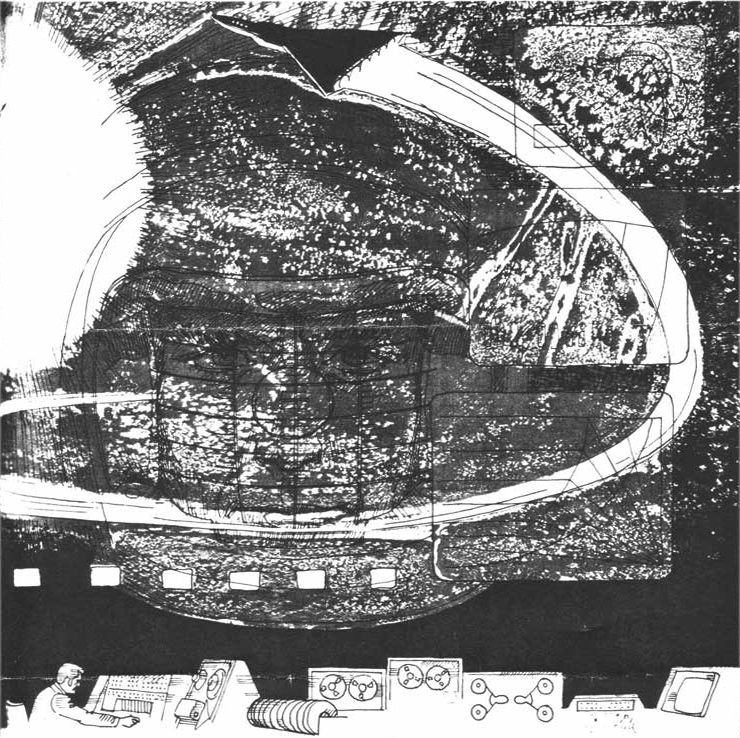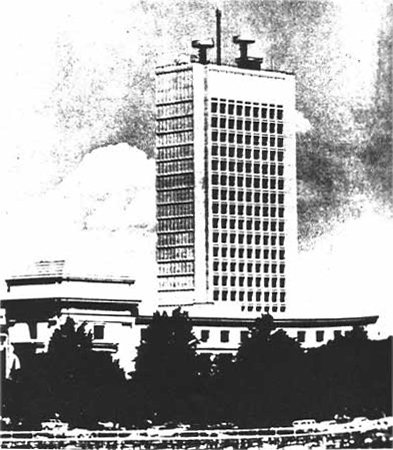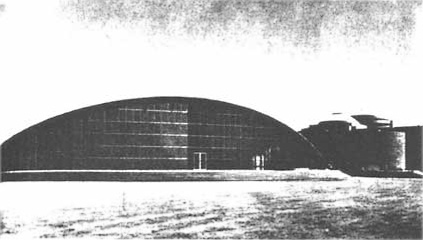SPACE WAR!
A Computer Game Today,
Reality Tomorrow?
by Joseph F. Goodavage

(SAGA is out of print and does not exist anymore. Joseph F. Goodavage deceased in April 1989.)
In the magazin's table of contents the article appeared as
«SPACEWAR! It’s a computer “game” played with simulated spaceships — but who will we use it against?».
The text represented here is a transliteration of scans to be found at http://www.kaleberg.com/spacewar/.

SAGA’s ace science reporter, Joseph F. Goodavage, had been invited to the Massachusetts Institute of Technology to try his hand at Spacewar – a computer “game” involving simulated spaceships, aerial torpedoes, maneuvers and tactics, a sun with a gravity field, all shown on a large cathode ray tube, and played with complex controls. But unlike those games in penny arcades, these sophisticated “toys” are being developed and refined by the military-industrial-academic complex. The questions nagging author Goodavage are: why, and who will we use them against?
”I have decided today that the United States should proceed at once with the development of an entirely new type of space transportation system designed to help transform the space frontier of the 1970s into a familiar territory, easily accessible for human andeavor in the 1980s and ‘90s…”
(Pres. Richard M. Nixon, Jan. 5, 1972)
At this very moment, while man is still probing the secrets of our solar system, he is also preparing for armed combat in deep space. As you read this tests are being conducted at government installations, “think tanks” like the Rand Corporation and some of the best universities in the nation. Altghough the prospect of battles between interstellar “cruisers” and “destroyers” in outer space seems remote, the fact is that armed combat in space is now talking place in the computer rooms of at least two large American institutions.
”Spacewar” was inaugurated at the Massachusetts Institute of Technolog several years ago. At the time it seemed extremely unlikely that such an extraordenarily complex setup – one costing a fortune to maintain and operate – could be a mere game. Dr. Jose Ortega, a scholarly, thoroughly knowledgeable expert on space technology, accompanied me there on one visit.
”Suppose ‘Spacewar’ is just a game — for now,” he said when I brought up the subject. “You have to keep two things in mind — one, the lesson of a few thousand years of human history, and two – the complexity of the national defense position. It’s only logical to assume that the Rand Corporation and other think tanks are working on advanced systems to protect man’s future in space. It’s the next step to taking artificial human environments to the Moon, Mars – or Venus,” he said, with his slight accent.
I agreed completely with Ortega and he now seemed even more enthusiastic than I was to see how computers had been programmed to realistically simulate battle between spacegoing dreadnaughts.
Two weeks earlier I had arranged an invitation to see “Spacewar” in operation and now I decided to take Dr. Ortega along as an expert witness. We drove up to the building housing most of what was called “Project Mac” at Massachusetts Institute for Technology. Inside, our footsteps echoed down one of the main corridors of MIT’s Artificial Intelligence Group at Cambridge. (The Artificial Intelligence Group has ben quietly working for the office of Naval Research to develop computer machines that react exactly like a human brain.) Within minutes we were escorted to the entrance of an installation a few of the graduate students jokingly called “The War Room”.
Among the rows of computers, relays, and other exotic equipment, I met my “enemy,” George Haskins, a lean, serious graduate engineer and cybernatics teacher in his early 30s. (Cybernetics is the new science of building feed back mechanisms into machines – the same type of systems that exist between human brain and body.) Haskins leaned casually against the wall close to a large 21-inch cathode ray tube and puffed on a cigarette. We soon learned that this tube would be the visual monitor for our “battle” in space.
Knowing it wasn’t the real thing took some of the exitement away but I still felt like a beginner about to face a chess master.
“This is probably similar to the method they used to train tail gunners in the early years of WW II,” Ortega said.

The Massachusetts Institute of Techology in Cambridge, Mass., where “Spacewar” was developed.
Ortega and I introduced ourselves to the shirt-sleeved Haskins and were in turn introduced to a few observers from other departments. I took in as much detail of the console, cathode ray tube, and control box of the PDP (Programmed Data Processor) computer as possible. I had been told beforehand that this computer performed 100,000 calculations per second! The machine did this as it interpreted the operator’s maneuvers, and that when it stored and plotted the relative positions and speeds of the nuclear torpedoes, the spaceships and the stars, the PDP-1 through 8 stored not only Newton’s laws of motions in its dense memory core, but many other calculations as well. These included the exact strength of the gravity field of the star, the speed and trajectory of both ships, their torpedoes, hyperspace “jumps,” etc.

“It may not be as complex as it looks,” Ortega whispered encouragingly. “It’s probably going to be fun…”
“I don’t know,” I said doubtfully.
“You’ll have to watch how he learns to control his ship,” Haskins said to Ortega. Unexpectedly, he handed me a remote control box studded with a simple array of switches that controlled the ship’s speed, direction, armaments, etc. After he had explained their purpose, I pressed a button and began a practice run using only one ship – the Arrow. The ship appeared on the CRT (Cathode Ray Tube) and cruised through the starfield under my direction. I grinned with pleasure and chuckled – the “game” was really phantastic!
Suddenly, the brilliant flare of an explosion blossomed in center screen – obviously the “destruction” of my ship.
“You let yourself too close to the star’s gravitational field,” Haskins announced drily. “Try again.”
I did – again and again. Each time I accidentially destroyed the Arrow in a tremendous nuclear blast when my ship came too close to the star. Finally I became accustomed to the controls. At this point, my deceptively calm, slightly balding “adversary-teacher” slid into place in front of the console and frowned intently at the control box.
Without further warning, he said, “We’ll try a couple of practice runs.” Without another word, he flipped a switch and the starfield leaped into view once again, but this time two spaceships were glowing on the screen.
The surrounding starfield is mainly for effect but these stars generate a sense of being in deep space, and provide good reference points against wich to judge your ship’s speed and trajectory. The blazing star in the center of the field, however, is quite a different case; as far as the spaceships and torpedoes are concerned, it possesses a “real” gravitational field. This permits any vessel with the correct angle and speed to assume a stable orbit around it. If your orbit is a little to close, however, the star’s gravity will grab your ship and destroy it.
In the split-second it took to orient myself, I realized that I was at immediate disadvantage. Haskins gradually seemed to change. Instead of a friendly teacher, he became an alien and unreasonable foe whose sole purpose was to destroy my ship. The game suddenly assumed crucial and deadly proportions. On the screen his ship, the Flying Wedge, had already jockeyed into battle position and was on a good approach vector. His trajectory had him on near collision course at a 30 degree angle with my ship. I could see the Arrow would be the first to reach the point of intersection.
Each of us had just so much fuel, and were equipped with an equal number of nuclear torpedoes, which could be fired in salvoes of four. The weapons are twice the size and triple the capacity of those aboard present day nuclear attack subs and are set to detonate on either direct contact or when they come to a natural magnetic field of an enemy vessel. I tried to a sprise maneuver, conserving as much fuel as possible, and jockeyed the Arrow into a wide, looping orbit around the central star. I was afraid of being dragged down, yet tried to use the star’s enormous gravitational pull as a kind of whiplash to drag me out of range of the Flying Wedge’s torpedoes.
Somehow, Haskins anticipated my evasive tactic. Instead of balsting off after me, as I had hoped — which might have put him beyond the point of no return where he would be dragged to a fiery death — the Flying Wedge rotated slowly in space beyond the gravitational reach of the Sun, and waited while inertia carried me arround the star. It didn’t help to see the ambush developing on the screen because I didn’t dare pull out of the elliptical solar orbit too soon for fear of being grabbed in the enormous gravitational influence of the star, which would have resulted in my ship’s being instantly vaporized. Instead, I concentrated on gently altering my orbit with a few balsts of the retro-rockets and slowly pulling away while trying to keep the star’s incandescent bulk between the Flying Wedge and myself.
In an instant the more experienced Haskins adjusted his trajectory and fired a deadly salvo of four nuclear torpedoes, which he fiendishly arranged to curve around the start’s gravity field. This made escape almost impossible for me but still, I pushed my controls clockwise in a long, desperate arc and the computer responded without a moment’s hesitation.
Now I had really gotten “into” the game! I could control the ship but only within the guidelines allowed by the computer programmers. I could almost feel my starship’s deck plates straining under my feet as the Arrow’s mighty rockets released their full reserve of power.
Too late! It was like making a stupid chess move, then realizing you’ve given your opponent the opportunity he needs for checkmate. The Arrow couldn’t possibly evade all the torpedoes — and my solar orbit was rapidly decaying. This meant my ship was slowly being drawn into the star’s corona and gravity field. In desperation, I punched a button that fired two torpedoes and cursed aloud as the Arrows was dragged to its doom by the sun’s inexorable gravity.
A momentarily brilliant flare on the screen marked the end of the first “command.”
“You forgot to hit the panic button.” Haskins again observed drily.
Like nearly everyone else who’d ever played this war game, I was instantly addicted and anxious for a rematch.
In the original version of “Spacewar” at Massachusetts Institute for Technology (the one on which all other space battles are patterned), the “panic button” activates hyperspace drive. This precision escape maneuver is intriguing because no faster-than-light drive now exists, but it adds interest and increased danger to the game. As soon as you hit the “panic button” your ship disappears beyond light velocity as if dematerialized. A few seconds later it reappeares elsewhere in the starfield on the screen — often parsecs from where it started! (A “parsec” is a combination of par(ellax) and sec(ond) and is a unit of measure for interstellar distances.) The operator doesn’t have the faintest idea where his ship will reappear! This is determined by a random selection in the computer’s programming. It’s a frightening effect because you just might emerge from hyperspace inside the sun — or on a collision course with a stray torpedo or an enemy ship. If you emerge within the star’s gravity field, chances are you’ll be dragged to a fiery doom — unless your reaction time is extremely fast, and you have plenty of fuel left.
When an enemy ship or torpedo is tracking your ship and there’s no way out, you have eight opportunities during the battle to escape almost certain destruction by hitting the pannic button that activates hyperspace drive.
But to dicourage excessive use of the panic button, the hyperspace drive becomes increasingly unreliable each time it is used. The first time you activate the hyperspace generators, there’s one chance in eight that your ship will explode when you pop out into “real” space where a ship experiences the subtle effects of special relativity after a journey through hyperspace. The second time, there are two chances in eight; on the third, three, and on the fourth four. Nobody has ever been known to hit the panic button the eighth time. The idea, of course, is to postpone the use of the hyperspace drive long enough for one craft or another to be blasted out of space by an enemy torpedo.
In spite of the vast amount of space in the CRT’s starfield, it’s obvious that the battle would soon become cramped if it were confined to “this” particular part of the Universe. Some sort of compensating factor was needed for the times when your vessel reached the outermost limit of known space — the edge of the cathode ray tube.
Because of the way the PDP line of computers handle positive and negative numbers, if your ship disappears off the edge of the screen in any direction, it will reappear within fractions of a second on the opposite side of the screen. When the Flying Wedge accelerated towards the top of the screen, I was able to fire the Arrow’s retro-rockets, and line up my ship’s torpedoes to face the position I figured the enemy would emerge when he reappeared from the bottom of the CRT. With a little practice, this can become a very effective method of destroying your opponent’s ship.
The speeds necessary for a fast paced [?, scan illegible] game makes this “space warp” concept almost a necessity. Instead of disappearing completely, or desintegrating when it flies off the lower left corner of the screen, a ship immediately reappears on the upper right corner.
A different version, called “Minnesota Spacewar” (originally played at the Univ. of Minnesota), has a variation of panic button use. Instead of disappearing and then reappearing at random, the Minnesota game allows the pilot to use skill instead of blind luck. In “Minnesota Spacewar,” your ship becomes instantly invisible when you hit the panic button.
You can’t see yourself, but then, neither can your opponent. The advantage lies with whoever is best at mentally plotting trajectories. Although your space is invisible, your rocket’s flaming exhaust is not! Every time you change course, your ship is momentarily visible, which helps you to calculate your position according to your timing and speed. Your opponent, however, can also do the same.
Remaining invisible for too long a period can be exceedingly dangerous. Running “blind,” you may ram your enemy headlong — or drift into the Sun without knowing it — until a brilliant nuclear explosion tells the story.
Limitations on the amount of fuel (and torpedoes) add to the realism of the battle. This is similar to the conditions that prevailed about WW II submarines (modern nuclear attack subs, powered by atomic reactors, can cruise indefinitely.)
The limits placed upon fuel and torpedoes requires additional skill for the combatants and make the outcome of the battle even more interesting and exciting. In “Minnesota Spacewar,” every ship has about 20 torpedoes and several minutes of fuel. In order to keep space from being cluttered with live torpedoes that missed their targets, but are still dangerously zooming around every which way — disappearing off one end of the CRT and reappearing on the other — they may be fired only at intervals of one second, and in salvoes of from one to four at a time. The lifetime of each torpedo is limited to about 20 seconds, and no more than four can be launched and armed at any one time.
Fuel is used only when the spaceships’ rockets are fired for acceleration, deceleration, or changes in course, so that the actual time of each flight exceeds the alloted two minutes of normally powered flight.
“Spacewar” can be reduced to three phases for maximum tactical value. A space battle between opposing ships (or whole fleets of ships) in a planetary system or starfield, begins with two motionless space vessels on opposite sides of the central star. Each fighter-astronaut tries to maneuver into a stable solar orbit with the largest possible elongation. This gives him the advantage of allowing his ship to “drift” in orbit while concentrating on lining up his opponent for a devastating torpedo blast.
By moving the control handle of his panel forward, the operator fires his aft rockets. Pulling it back fires the retro-rockets in the ship’s nose. To make his ship rotate counterclockwise, the commander pushes the gyroscopic control to the left; to rotate in a clockwise direction, he pushes it to the right. If there’s a direct hit or even a grazing contact, the enemy ship will disintegrate in a burst of unleashed nuclear power that appeares on the screen as a sparkling flare expanding outward from a central point as a real stellar explosion (or nova) would appear.
Next to the enemy’s ship, the central star is the most important element in the battle. It destroys more amateur space warriors than any number of enemy torpedoes. Five times during the first dozen battles, I actually destroyed the Flying Wedge, but while concentrating on my aim, the Sun’s gravity pulled with a force that was too much for my rockets to overcome. Four times my ship fell to an explosive end.
Even if it were “just a computer game,” it would be an exhilarating experience. The opponents are equally matched in every respect. Skills develop with each battle. Regardless of your experience, however, you’re still a mere beginner until you master the art of keeping the central star’s gravity field constantly in mind during every calculation and maneuver. These calculations are similar to an astronaut jockeying his capule, a pilot maneuvering his plane, or a truck driver backing into a tight spot. Once you’ve mastered the use of the gravity field, it can serve you in many ways. For example, it can become a “baited” trap (using your own ship as the bait) for an unwary attacker, and a positive force in your favour when you’ve learned how to use it. In the beginning, Haskins’ Flying Wedge dropped deep into the gravity field and took up an elliptical orbit which made him far more difficult to hit with a torpedo. On one occasion however, I had the double pleasure of catching him with an armed broadside, then — an instant later — seeing the debris from a secondary bloom of nuclear fire as the Flying Wedge plummeted toward the star’s core.
“If you still think ‘Spacewar’ is just a computer ‘game,’ keep this in mind,” Haskins said. “Theoretical physicists during the late 1930s and early ’40s didn’t have the slightest intention of developing hydrogen bombs capable of wiping out whole cities …”
“That’s right,” Ortega agreed, “they were ‘just looking’ into the mysteries of atomic energy. But we’ve now reached the point where it is ‘unthinkable’ for any nation to launch a nuclear holocaust — at least on Earth.”
“Deep space is the only logical place for future atomic warfare,” Haskins said soberly.
My mind was reeling from these statements. More and more nations increasingly rely on high-speed computers to plan and direct their economies, international trade, and — quite possibly — future wars. “Are you saying, we’ll have space battles with Russia, China, Japan, Germany, or other countries?”
“Look at it this way,” Haskins said, “either we’re getting ready for space battles with other Earth nations, or —” he hesitated, “somebody believes we’re going to have serious differences with alien civilizations and beings far beyond the solar system.”
In either case, the underlying reasons for “Spacewar’s” existence are infinitely more complex than they seem to be.
Consider this: when I went back to MIT to recheck a few details about “Spacewar” everything had changed. What was once a tightly-knit, intense group of graduate student engineers, and technologists had become a wall of blockading bureaucrats. Some people actually claimed never to have heared about “Spacewar”! Those who did hinted that there was a lot of government pressure due to classification of the “game.” I couldn’t even find George Haskins, my former “enemy” nor could I find his address or phone number.
Has “Spacewar” become more than the game it appears to be? Has the theory of intergalactic battles gone beyond the laboratory stage? And, most crucial, who are we getting ready to engage accross the vast reaches of space?
* THE END
Editorial Note:
While SAGA magazin does not exist anymore and the author deceased in 1989, copyrights might still apply.
Unable to track any possible owners, the text is here provided in good faith as a quotation of material found elsewhere (see the source annotation at the top) in order to document historic resources related to the computer game "Spacewar!".
Type-setting is as close to the original as possible with respect to the requirements of on-screen presentation.
The closing of the piece clearly draws from the announcement of the public demo of Spacewar! in the course of the MIT Parents’ Weekend, Sat. 28 – Sun. 29, April 1961, published in MIT’s “The Tech” magazine (Vol. 82, Issue 11, April 25, 1962, p.11), which closes with the following tongue-in-cheek considerations:
“As an example of the whimsical uses of computers this is something parents shouldn’t miss. As a simplistic preview of future war games, it might well be classified were this report to fall into the wrong hands.”